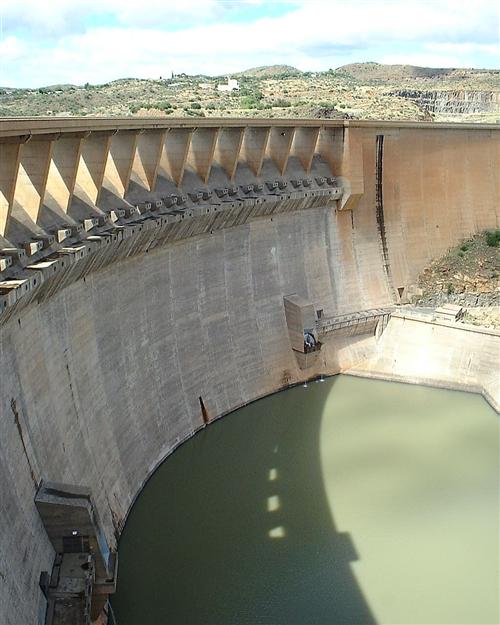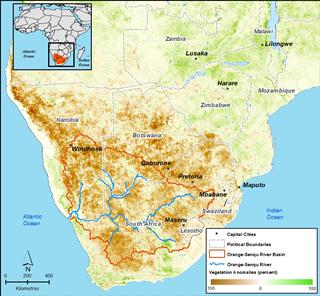Droughts are among the most serious consequences of water scarcity. Scientists define four types of drought, as described in the box below:
Box 1: Definitions for Various Drought Types
Meteorological drought is a reduction in rainfall compared with the average over a specified period. A drought is said to occur when a large area receives rainfall less than 75% of normal for an extended period.
Agricultural drought is inadequate supply of the moisture required by a crop during each different growth stage, resulting in impaired growth and reduced yields.
Hydrological drought is the impact of a reduction in rainfall on surface and underground water resources that reduces the supply of water for irrigation, hydro-electrical power generation, and other household and industrial uses.
Socio-economic drought relates to the impact of drought on human activities, including both indirect and direct impacts on agricultural production and the wider economy.
Source: INGC/ FEWS NET Mind 2003

Dams such as Vanderkloof can provide a buffer in drought conditions.
Source:Pyke 2003
( click to enlarge )
The frequent occurrence of El Niño Southern Oscillation (ENSO) phenomena complicates the expected rainfall pattern that is normally controlled by the movement of the Inter-Tropical Convergence Zone (ITCZ).
Economic development in developing countries is currently threatened by weather-related disasters such as floods and droughts. Water shortages can seriously harm the economy of a country or region, constraining development and reducing economic growth as financial and hydrological resources are expended to counter the drought. Multi-year droughts can have a lasting legacy, resulting in long-term suffering for agriculturally dependent rural communities and reducing national and regional growth rates significantly.
The map below shows satellite-based measurements of vegetation as an indicator of water stress and drought occurrence in 2007.
 Satellite-based measurements of vegetation as an indicator of drought from 2007 (see description below). Source:NASA GIMMS Group at Goddard Space Flight Center 2007 ( click to enlarge ) |
Box 2: Drought in Southern Africa 2007
Hot, dry weather from January through March 2007 wilted crops in southern Africa. The severe drought produced near-record temperatures that, combined with a lack of rainfall, caused extensive crop damage, particularly in western crop areas, reported the United States Department of Agriculture’s Foreign Agricultural Service. In South Africa, the anticipated yield from the corn crop dropped from ten million tons in December to six million tons in April because farmers couldn’t plant in the dry conditions and many of the crops that were planted wilted in the dry heat. The last South African drought of this magnitude occurred in 1992.
The impact of the drought on vegetation throughout southern Africa is illustrated in this image. The image shows vegetation conditions in March 2007 compared to conditions during the average March between 1999 and 2006 as measured by the SPOT satellite. Brown areas show where plants were less thick or where fewer plants grew than average. Green areas, by contrast, indicate that vegetation was thicker and more lush than average.
Source: NASA Earth Observatory 2010
Impacts of Drought
Drought is often seen as simply an agricultural and food supply issue, but studies have shown that the impacts of droughts are far-reaching, with significant economic, environmental and social impacts. The table below, adapted from Vogel, Laing and Monnik (1999), summarises the impacts of drought in Southern Africa, these issues are relevant to drought vulnerable areas around the world.
Table: Impacts of drought in southern Africa
|
Primary impacts
|
Secondary impacts
|
|
Social
|
|
Disrupted distribution of water resources
|
Migration, resettlement, conflicts between
water users
|
|
Increased quest for water
|
Increased conflicts between water users
|
|
Marginal lands become unsustainable
|
Poverty, unemployment
|
|
Reduced grazing quality and crop yields
|
Overstocking; reduced quality of living
|
|
Employment lay-offs
|
Reduced or no income
|
|
Increased food insecurity
|
Malnutrition and famine; civil strife and conflict
|
|
Increased pollutant concentrations
|
Public health risks
|
|
Inequitable drought relief
|
Social unrest, distrust
|
|
Increased forest and range fires
|
Increased threat to human and
animal life
|
|
Increased urbanization Social pressure,
reduced safety
|
|
|
Environmental
|
|
Increased damage to natural habitats
|
Loss of biodiversity
|
|
Reduced forest, crop, and range land
productivity
|
Reduced income and food shortages
|
|
Reduced water levels
|
Lower accessibility to water
|
|
Reduced cloud cover
|
Plant scorching
|
|
Increased daytime temperature
|
Increased fire hazard
|
|
Increased evapotranspiration
|
Crop withering and dying
|
|
More dust and sandstorms
|
Increased soil erosion; increased air
pollution
|
|
Decreased soil productivity
|
Desertification and soil degradation
(topsoil erosion)
|
|
Decreased water resources
|
Lack of water for feeding and drinking
|
|
Reduced water quality
|
More waterborne diseases
|
|
Economic
|
|
Reduced business with retailers
|
Increased prices for farming commodities
|
|
Food and energy shortages
|
Drastic price increases; expensive
imports/substitutes
|
|
Loss of crops for food and income
|
Increased expense of buying food, loss of income
|
|
Reduction of livestock quality
|
Sale of livestock at reduced market price
|
|
Water scarcity
|
Increased transport costs
|
|
Loss of jobs, income and property
|
Deepening poverty; increased unemployment
|
|
Less income from tourism and recreation
|
Increased capital shortfall
|
|
Forced financial loans
|
Increased debt; increased credit risk
for financial institutions
|
Source: FAO 2004, adapted from Vogel, Laing and Monnik (1999)
